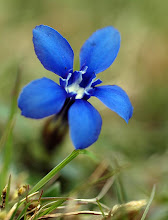This little barrel-shaped grub is the larval stage of a picture-winged fly Urophora jaceana, which spends the winter hidden deep inside the seed head of a knapweed plant. Late last summer the adult female fly would have....
...laid its eggs in a knapweed flower like this and since then the larvae have been feeding on the developing seeds inside. The larvae induce the formation of a hard, woody gall inside the seedhead so if you.....
... gently squeeze a seed head like this one you'll find some that are squashy and some that have a hard lump inside, which is the Urophora gall. If you carefully cut the gall open ...
.. the larvae are revealed in their chamber inside. Here, a fully-fed larva is on the right and one that has developed into a pupa is on the left.
By this stage most of the seeds (on the right here) have usually been eaten but sometimes you'll find a few survivors.
This pupa will hatch out early this summer, just in time to lay eggs in a new crop of knapweed flower buds.
European knapweed species were taken to North America and have since become noxious weeds there. In an attempt to control them Urophora species, which can have a major impact on the plants' reproductive capacity, were introduced too as a biological control agent. The gall fly hasn't halted the spread of the knapweed but it has provided a nourishing food supply for North American deer mice in winter, to the extent that in Montana there has been a population explosion of well-fed deer mice. When the ground is covered in snow they climb the knapweed stalks and eat the Urophora grubs. The sudden population increase is causing some concern since they carry hantavirus, which is present in their urine and can be transmitted to humans - an unexpected consequence of a chain of events that started with Europeans carrying knapweed to the United States. It's also another example of how biological control techniques can have broader consequences than intended by those who introduced the biological control agents. Curiously, I don't think our local native field mice in Britain have yet discovered that there's a rich source of animal protein in the gall-fly infested knapweed seed heads - after the recent heavy snowfalls I couldn't find any evidence of field mice having foraged on knapweed seed heads around here. Maybe deer mice are just a bit smarter...........












































